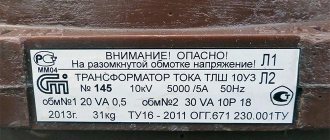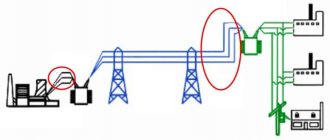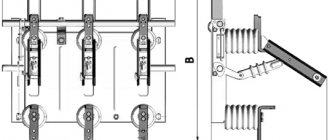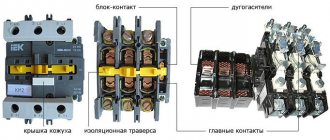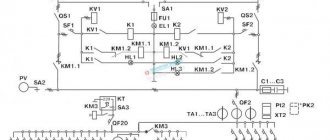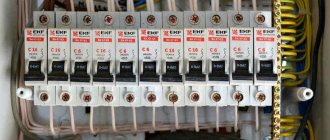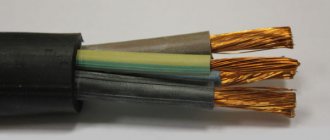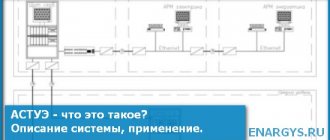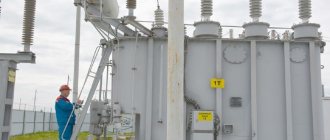Switchgears are designed to receive electrical energy from generators, transformers or power lines and distribute it among consumers.
• PSN — AC auxiliary panels of the PSN series are designed for input and distribution of alternating current electrical energy with a frequency of 50 Hz and a voltage of 380 V from an auxiliary power transformer with a power of up to 1000 kVA and are used to complete auxiliary panels at power plants, substations, and energy facilities voltage up to 750 kV. Cost: from 950,000 rub. • EPZ – EPZ type panels are designed to perform longitudinal differential current protection of parallel lines with a voltage of 110 – 220 kV as the main protection. Cost: from 80,000 rub. • SHERA – designed to perform the functions of control, protection, signaling, measurement and monitoring of electric current at power plants with voltages up to 110–220 kV. Cost: from 400,000 rub. • YAZV – Cabinets and terminal boxes are designed for connecting secondary circuits of open switchgears (OSG) of power plants and substations. Equipped with three-pole power switches and sectioning of blocking circuits. Oil seals are supplied upon request. Cost: from 2500 rub. • YAZSh – Substation boxes are used in electrical installations involved in the production and distribution of electricity, designed for the assembly of secondary switching circuits. Organization of current circuits for differential busbar protection. Cost: from 2500 rub. • kV - kilo-Volt, i.e. 1000 Volts (voltage unit).
• NKU – low-voltage complete device
What is KTP
KTP (complete transformer substation) is an electrical installation that is designed to receive voltage, convert it into electric current, and then distribute electricity to consumers in the household network. KTP includes:
- RUVN - a device capable of distributing higher voltage
- RUNN - a device capable of distributing low voltage
- power transformer
- various complementary designs that can be manufactured as needed.
What is the difference between TP and KTP
Transformer substation (TS) is an electrical installation for increasing or decreasing the voltage in the electrical network. The device receives, converts and distributes electrical energy across consumer power supply systems. The main elements of the equipment are power transformers.
Transformer substations are used for different purposes.
- Nodal distribution substation (URS). The device receives electrical energy with a voltage (U) of 110-220 kV, distributes it with or without incomplete transformation to a deep input substation at U = 35-220 kV.
- Transformation point (TP). Powers receivers at voltages up to 400 V. Primary U - 6/10/35 kV.
- Deep entry substation (DHS). The device powers several production units or a separate facility. PGW receives energy from the power system itself or the central distribution point in production. U at the input - 35-220 kV.
- The main step-down substation (MSS) is installed at enterprises, receives electrical energy from a regional source at U from 35 to 220 V, and redistributes it at a reduced voltage.
Complete transformer substation (KTP) is an electrical installation that receives current from a power plant with a rated voltage of 6-10 kV and converts it into a current of 0.4 kV. The equipment consists of high and low voltage switchgear, a power or dry transformer and additional elements: insulators, fuses, an element for electricity metering, power switches, etc., depending on the model.
KTP, unlike PT, is supplied by the manufacturer in a fully equipped form. The transformer substation is assembled in parts: a room for the equipment is built separately, and components are purchased separately. This is the difference between the devices.
Differences between KTP and KTPN
The configuration and type of package transformer depends on the place of its use. It is installed:
- inside buildings as built-in equipment, an extension (built-in, attached);
- inside the workshop (shop);
- outside structures in the form of iron kiosks (kiosk);
- outdoors on special masts with a maintenance platform (mast);
- in the open air on poles with assembly on prepared supports of overhead power lines (pole).
The last three devices are classified as KTPN - outdoor KTP. This subtype of complete TP is installed on the street. The design of the KTPN is adapted to precipitation, temperature fluctuations, street dust and dirt. It consists of a power frame with panel cladding. The latter is made from thick steel sheets.
Differences between KTP and BKTP
Block complete transformer substation (BCTS) is an electrical installation intended for outdoor use. Electrical equipment is mounted in a reinforced concrete housing, similar to a small building, and in this form is transported to the site. The roof of the structure is reinforced with heat and waterproofing materials, and grilles are installed in the doors and gates for natural air circulation.
The difference between KTP and BKTP lies in the design and dimensions of the electrical equipment. The complete TP is smaller than the block one and has a more compact body made of metal. In addition, the first substation supplies electricity to small settlements and construction sites. The second is larger industrial enterprises, large settlements, and individual areas of the city.
What is TP
TP (transformer substation) is an electrical installation that is used only for the conversion and distribution of electrical energy. The TP usually includes:
- one or more transformers
- current distribution devices
- protective equipment
- measuring device
Also, a distinctive feature of KTP from TP is that the complete transformer substation is produced immediately in full factory readiness.
INPUT AND DISTRIBUTION DEVICES IN THE RESIDENTIAL SECTOR
The input distribution device is designed for receiving, metering and distributing electrical energy with a voltage of 380/220 V three-phase alternating current with a frequency of 50 Hz in networks with a solidly grounded neutral, to protect lines during overloads and short circuits, as well as for infrequent operational switching on and off. • ASU – One-way service panels are used in civil engineering to supply electricity to the residential sector. Cost: from 7500 rub. • ShchE – Floor panels are designed for apartments in multi-storey buildings. Cost: from 4200 rub. • ShchK – Apartment panels are designed for individual houses, cottages with voltages up to 220V. Cost: from 1500 rub. • ShchG – Garage panels assemblies are designed for installation in garages to protect outgoing lines during overloads and short circuits, as well as for infrequent operational switching on and off. Cost: from 600 rub. • YaTP boxes – designed to convert 220V, 380V AC voltage with a frequency of 50Hz into safe voltage 12V, 24V, 36V and 42V. The boxes are used to power repair lighting lines, connect portable lamps and power tools. Cost: from 850 rub. • ShRUE panels – designed for public, trade pavilions and other buildings and structures, including metal structures with increased electrical safety requirements. Cost: from 2500 rub. • ShRE – electrical distribution cabinets are designed for public, trade pavilions and other buildings and structures, including metal structures with increased electrical safety requirements. Cost: from 1500 rub. • OSHV – distribution board, lighting, designed for lighting networks and for individual power supply. Cost: from 650 rub. • ШУО – Lighting control cabinets are designed to provide electricity to external (street) lighting networks with an alternating current frequency of 50 Hz and a voltage of 380/220 V with a solidly grounded neutral. Cost: from 25,000 rub. • Shields of the ShchAP type are designed to automatically switch to backup power supply of lighting circuits and power equipment when the voltage on the working feeder disappears and to return electrical circuits to their original state when normal voltage is restored in the network. Cost: from 3500 rub. • Y5000 – Control boxes for asynchronous motors of the Y5000 series are designed for continuous operation (starting an electric motor and turning off a rotating motor). Cost: from 2500 rub. • Any non-standard equipment for input and distribution devices in the residential sector according to the customer’s questionnaire.
Types of package transformer substations
CTPs come in different types and types, and therefore can also differ significantly from each other. Complete transformer substations are classified into the following types:
- KTPN. These substations are manufactured only for outdoor installation (kiosk type). Their power can reach 10-2500 kVA, and the voltage can vary in the range of 6-35 kV.
- 2KTPN. The design of this substation is similar to the previous one, but the main difference is the presence of not one, but two transformers, allowing the substation to operate more efficiently.
- KTPU and 2KTPU. Substations of this type have so-called sandwich panels that insulate them. Due to this, the equipment can be used in conditions of low temperatures – down to -60 degrees Celsius.
- KPTM. Mast substations that serve to supply energy to oil wells and small settlements.
- KTPS. Pole models are usually mounted on metal or reinforced concrete structures. They are used mainly on agricultural sites or holiday villages.
- KTPV. This type of substation is intended for indoor installation. Such models find their application in manufacturing enterprises.
This is what actually distinguishes one type of QTS from another type of QTS.
Basic abbreviations in electrical engineering and energy.
In many documents and literature there are abbreviations that we should know as if by default. Therefore, I am posting a small selection of such abbreviations so as not to be confused in the future. You can also look at information on the topic: Decoding the abbreviations of cables and wires.
| Abbreviations in electrical engineering, energy, interpretation. This list is an incomplete reference to basic electrical engineering terms. | |
| Abbreviation | Decoding the abbreviation |
| AB | circuit breaker |
| HELL | asynchronous motor |
| AVR | automatic reserve entry |
| Automatic reclosing | automatic restart |
| ACS | automated control system |
| APCS | automated process control system |
| ASCHSU | control station unit panel |
| ASKUE | automated system for monitoring and accounting of electricity consumption |
| BPN | voltage power supply |
| BPT | current power supply |
| BKTP | block complete transformer substation |
| VL | overhead line |
| VN | load switch |
| VR | switch-disconnector |
| VSN | departmental building codes |
| GRP | switch-disconnector-fuse |
| ASU | input distribution device |
| VRSH | input distribution board |
| WAZP | rectifier unit charging, recharging |
| GK | configuration group |
| GR | implementation group |
| HS | warehousing group |
| GT | transportation group |
| main switchboard | Main switchboard |
| GPI | State Design Institute |
| GPP | main step-down substation |
| GTR | current production preparation group |
| SAPP | group of advanced production preparation |
| ZRU | closed switchgear |
| ICC | information and computing center |
| UPS | uninterruptable power source |
| short circuit | short circuit |
| KU | capacitor unit |
| KL | cable line |
| KRM | reactive power compensation |
| KTP | complete transformer substation |
| Efficiency | efficiency |
| KVU | complete rectifier device |
| KOU | complete lighting devices |
| KRU | complete switchgear |
| CSR | complete camera for one-way maintenance |
| KTP | complete transformer substation |
| KTU | labor participation rate |
| KUHN | low voltage capacitor unit |
| GIS | gas-insulated switchgear |
| KSUKEMR | comprehensive quality management system for electrical installation work |
| Power lines | power line |
| OHL | overhead power line |
| MU | installation management |
| MTS | logistics |
| MEZ | Electrical parts workshop |
| NV | low voltage |
| NN | low voltage |
| NAU | low voltage control equipment |
| NKU | low voltage complete devices |
| NIS | regulatory research station |
| NOT | scientific organization of labor |
| EDC | operational dispatch group |
| RAM | random access memory device |
| outdoor switchgear | open switchgear |
| Quality Control Department | technical control department |
| OKPU | operational scheduling and management |
| PS | circuit diagram |
| PU | control station |
| PVR | fuse-switch-disconnector |
| PGV | deep entry substation |
| ROM | programming memory |
| POS | construction organization project |
| PPR | project of work production |
| PRA | ballast |
| PUE | electrical installation rules |
| PTK | software and hardware complex |
| PTEEP | rules for technical operation of electrical installations by consumers |
| RU | Switchgear |
| RM | reactive power |
| RZ | relay protection |
| RP | distribution point |
| RShch | switchboard |
| RTP | distribution transformer substation |
| on-load tap-changer | voltage regulation under load |
| Relay protection and protection | relay protection and automation |
| RZAiT | relay protection, automation and telemechanics |
| CH | average voltage |
| SD | synchronous motor |
| SK | synchronous compensator |
| NW | Remedies |
| SET | electronic tariff meter |
| SAR | automatic control system |
| FROM TO | estimate and contract department |
| SPU | network planning and management |
| CAD | computer-aided design system |
| SNiP | building regulations |
| TP | transformer substation |
| TT | current transformer |
| TN | voltage transformer |
| Chamber of Commerce and Industry | technological preparation of production |
| TSU | thyristor control station |
| TEP | feasibility planning |
| RCD | residual current device |
| UPT | tariff switching device |
| UKP | complete power supply device |
| UKM | power compensation device (installation) |
| UKRM | reactive power compensation device (installation) |
| UIPP | production engineering preparation area |
| UKST | picking, storage and transportation area |
| UPTK | production and technological equipment management |
| XX | idling |
| CPU | CPU |
| TsNIB | central regulatory research bureau |
| SHA | automation cabinet |
| SHU | accounting cabinet |
| SHNN | low voltage cabinet |
| SEAN | voltage take-off cabinet |
| SHOT | operating current cabinet |
| ShRS | power distribution cabinet |
| SHRNN | low voltage distribution cabinet |
| SHRPT | DC distribution cabinet |
| SHUOT | operating current control cabinet |
| SCHO | one-way service distribution board |
| SCHO | lighting board |
| SCHA | automation shield |
| ShchR | distribution board |
| ShchS | power shield |
| control room | switchboard |
| ShchAO | lighting automation panel |
| SHAU | automation and control panel |
| SHPT | DC switchboard |
| ShCHSN | own needs shield |
| EO | electrical equipment |
| EU | electrical device |
| EE | Electric Energy |
| EMF | electromotive force |
| computer | electronic computer |
| EHR | wiring kit |
| EMR | electric installation work |
| EMU | electrical control |
| AMY | electromagnetic radiation |
What is the difference between KTP and KTPN
KTP and KTPN are two similar names that seem to be no different, but there are still differences. KTPN (complete transformer substation for outdoor installation) is one of the types of KTP (complete transformer substation), the peculiarity of which is that it is installed and operated only outside buildings. The KTPN design can operate in any weather conditions, with various temperature changes, as well as heavy rainfall and strong winds. These characteristics distinguish KTPN from KTP.
In this article we will look at what a PTS , what kind of PTS there are, what they are intended for, what is their design difference and why there is confusion in their types. For an accurate understanding, we will need the following definitions: clause 4.2.6 (PUE Seventh Edition): Transformer substation (TS) is an electrical installation designed for receiving, converting and distributing energy and consisting of transformers, switchgear, control devices, technological and auxiliary structures. clause 4.2.10 (PUE Seventh Edition): KTP - complete transformer substation - substation, consisting of transformers, units (switchgear switchgear and switchgear switchgear) and other elements supplied assembled or fully prepared at the manufacturer for assembly. A large selection of standard substation solutions is presented in our “ Regulatory Base ” in the corresponding section . The definitions are quite accurate and comprehensive, however, it is common to hear that when it comes to package transformer substation, carried out according to standard specifications from MOESK, the talking parties imagine different devices. So that all parties see the same picture, let's consider variations of QFT.
The most common TP for individual buildings, villages, individual plots is MTP . The mast transformer substation is the cheapest transformer substation, often called “Collective Farmer” because of its low cost and extremely simple design. The appearance and possible dimensions of the MTP are presented in the figure below: MTP is an open transformer substation, all of the equipment of which is installed on structures (including two or more racks of overhead line supports) with a service platform at a height that does not require fencing of the substation. In this case, it is important to note that this type of substation does not require fencing of the substation. MTP is often performed in sizes from 25 kVA to 250 kVA .
An equally common TP for power supply to plots, individual cottages and other consumers up to 63 kVA is STP (OSTP) . STP (OSTP) - Pole (Single-Pole) transformer substation is a type of collective image of a package transformer substation; the most common type is STS assembled on one support. The appearance and possible dimensions of the STP (OSTP) are presented in the figure below:
STP equipment:
1. Transformer. 2. Cabinet RUNN. 3. Fuse. 4. Valve arrester (surge suppressor). 5. Cross beam 0.23 kV. 6. Cross beam 10 kV.
STP (OSTP) is an open transformer substation, all the equipment of which is installed on a single-column overhead line support at a height that does not require fencing of the substation. STP (OSTP) is often performed in sizes up to 63 kVA .
The next segment is more expensive PS. KTPSH - A complete cabinet-type transformer substation is a type of KTP; the most common type is KTPSH assembled on 4 stepsons (USO racks) with the presence of a RUNN and UVN cabinet. Unlike previous variations, KTPSH requires a fence; as a rule, it is mesh. The appearance and possible dimensions of the KTPSh located on the stepsons (USO racks) are shown in the figure below:
KTPSH equipment : 1. Transformer. 2. Fuse cabinet. 3. Cabinet RUNN. 4. Protective casing for transformer terminals. 5. 10 kV bushing insulator. 6. Pin insulator 10 kV. 7. Valve arrester (surge suppressor). 8. Rack USO 3A, length 3600mm.
This article covers most of the variations of QTP, but not all; gradually the article will be supplemented with new, less common TP. Continuation of the article - KTPTAS (KTPPAS), KTPGS, KTPN , KTPNU You can discuss this article on our forum, your opinion and your vision of the situation are very important to us
